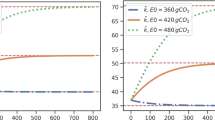Abstract
According to optimal taxation theory, raw materials should be taxed to capture the embedded scarcity rent in their value. To reduce both natural resource use and the corresponding emissions, or the throughput in the economic system, the best policy may be a tax on material inputs. As a first approach to throughput taxation, this paper considers a tax on intermediates in the framework of a dynamic computable general equilibrium model with environmental feedbacks. To balance the budget, payroll taxes are reduced. As a result, welfare indicators as material consumption and leisure time consumption are reduced, while on the other hand all the environmental indicators improve.
Similar content being viewed by others
References
Alfsen, K., T. Bye and E. Holmøy (eds.) (1996), 'MSG-EE: An Applied General Equilibrium Model for Energy and Environmental Analyses' in Social and Economic Studies no. 97, Statistics Norway.
Ayres R. U and A. V. Kneese (1969), 'Production, Consumption, and Externalities', American Economic Review LIX, 282–297.
Barro, R. J. (1974), 'Are Government Bonds Net Wealth?', Journal of Political Economy 82(6), 1095–1117.
Biørn, E. and E. Jansen (1982), 'Econometrics of Incomplete Cross-section/ Timeseries Data: Consumer Demand in Norwegian Households 1975-1977', in Social and Economic Studies no. 52, Statistics Norway.
Bovenberg, A. L. and R. A de Mooij (1994), 'Environmental Levies and Distortionary Taxation', American Economic Review 94, September, 1085–1089.
Bovenberg, A. L. and F. v. d. Ploeg (1994), 'Green Policies and Public Finance in a Small Open Economy', Scandinavian Journal of Economics 96(3), 343–363.
Brendemoen, A., S. Glomsrød and M. Aaserud (1992), 'Miljøkostnader i makroperspektiv' (Environmental Costs in Macro-perspective), Reports 92/17, Statistics Norway.
Bruvoll, A. (1998a), 'Taxing Virgin Materials: An Approach to Waste Problems', forthcoming in Resources, Conservation and Recycling.
Bruvoll, A. (1998b), 'The Costs of Alternative Treatments of Paper and Plastic Waste', Report 98/2, Statistics Norway.
Bruvoll, A., S. Glomsrød and H. Vennemo (1998), 'Environmental Drag: Evidence from Norway', forthcoming in Ecological Economics.
Bruvoll, A and K. Ibenholt (1997), 'Future Waste Generation. Forecasts Based on a Macroeconomic Model', Resources, Conservation and Recycling 19, 137–149.
Dagsvik, J. K. and S. Strøm (1992), 'Labour Supply with Non-Convex Budget Steps, Hours Restrictions and Non-Pecuniary Job-Attributes', Discussion Paper 76, Statistics Norway.
Daly, H. and R. Goodland (1993), 'Why Northern Income Growth is not the Solution to Southern Poverty', Ecological Economics 8, 85–101.
Fløttum, E. J. and T. Skoglund (1997), 'Labour Productivity Growth in Norway Using National Accounts Data', Economic Survey 4/97, Statistics Norway.
Glomsrød, S., R. Nesbakken and M. Aaserud (1994), 'Modeling Impacts of Traffic Injuries on Labour Supply and Public Health Expenditures in a CGE Framework', Mimeo, Statistics Norway.
Goulder, L. H. (1994), 'Environmental Taxation and the Double Dividend. A Reader's Guide', Paper prepared for the 50th Congress of the International Institute of Public Finance.
Goulder, L. H. (1995), 'Effects of Carbon Taxes in an Economy with prior Tax Distortions: An Intertemporal General Equilibrium Analysis', Journal of Environmental Economics and Management 29, 271–297.
Jorgensen, D. W and P. J. Wilcoxen (1994), 'Reducing U. S Carbon Emissions: An Econometric General Equilibrium Assessment', in D. Gaskins and J. Weyant eds., The Costs of Controlling Greenhouse Gas Emissions, Stanford: Stanford University Press.
Ministry of Finance (1993), 'Langtidsprogrammet 1994-1997', St. meld. nr. 4 (1992-93) (Report no. 4 to the Storting (1992-93): Long-Term Program 1994-1997). (Parts of the report are available in English).
Obstfeld M. (1982),'Aggregate Spending and the Terms of Trade: Is there a Laursen-Metzler Effect', Quarterly Journal of Economics 97, 251–270.
Olsen K. (1995), 'Nytte-og kostnadsvirkninger av en norsk oppfyllelse av nasjonale utslippsmålsettinger' (Cost-and Benefit Implications of a Norwegian Fulfillment of National Emission Targets), Notater 95/7, Statistics Norway.
Olsen K. and H. Vennemo (1994), 'Formue, sparing og vekst: En analyse av Langtidsprogrammets perspektiver' (Wealth, savings and growth: An analysis of the perspectives of the Long-term program), Sosialøkonomen 9, 32–38.
Repetto, R. (1994), 'Shifting Taxes from Value Added to Material Inputs', World Resources Institute, paper presented at the International Workshop on 'Environmental Taxation, Revenue Recycling and Unemployment', Milan, December 16-17, 1994.
Steffensen. E. (1989), 'Konsumetterspørselen i Norge estimert ved hjelp av Eulerlikninger p å årsdata 1962-1987' (Estimating the Demand for Consumption in Norway by Means of Euler Equations on Annual Data, 1962-1987), Working Paper 20/89, Centre for Applied Research, Norwegian School of Economics and Business Administration, Bergen.
Vatn, A. and E. Romstad (1995), 'Input Vs. Emission Taxes, Green taxes in Mass Balance and Transaction Costs Perspective', Discussion Paper #D-6/1995, Agricultural University of Norway.
Vennemo H. (1994), 'Welfare and the Environment. Implications of a recent Tax Reform in Norway', Documents 94/1, Statistics Norway.
Vennemo H. (1997), 'A Dynamic Applied General Equilibrium Model with Environmental Feedbacks', Economic Modeling 14, 99–154.
Author information
Authors and Affiliations
Rights and permissions
About this article
Cite this article
Bruvoll, A., Ibenholt, K. Green Throughput Taxation: Environmental and Economic Consequences. Environmental and Resource Economics 12, 387–401 (1998). https://doi.org/10.1023/A:1008234017015
Issue Date:
DOI: https://doi.org/10.1023/A:1008234017015



